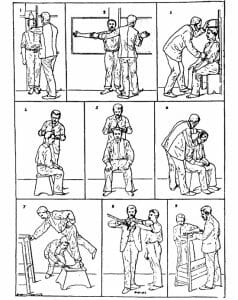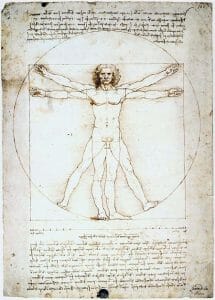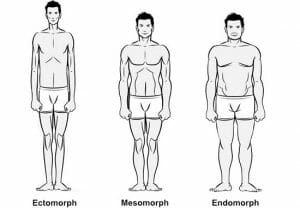Anthropometry Definition
Anthropometry is the science of obtaining systematic measurements of the human body. Anthropometry first developed in the 19th century as a method employed by physical anthropologists for the study of human variation and evolution in both living and extinct populations. In particular, such anthropometric measurements have been used historically as a means to associate racial, cultural, and psychological attributes with physical properties. Specifically, anthropomorphic measurements involve the size (e.g., height, weight, surface area, and volume), structure (e.g., sitting vs. standing height, shoulder and hip width, arm/leg length, and neck circumference), and composition (e.g., percentage of body fat, water content, and lean body mass) of humans.
Anthropometric Tools
To obtain anthropometric measurements, a variety of specialized tools (as depicted below) are used:
- Stadiometers: height
- Anthropometers: length and circumference of body segments
- Biocondylar calipers: bone diameter
- Skinfold calipers: skin thickness and subcutaneous fat
- Scales: weight
Although the majority of the instruments appear straight forward to use, a high level of training is required to achieve high validity and accuracy of measurements.
Who Developed Anthropometry: Alphonse Bertillon (1853-1914)
Alphonse Bertillon was the son of the physician and founder of the Society of Anthropology of Paris, Louis-Adolphe Bertillon. Although the process of obtaining human measurements had originated in ancient civilizations, Alphonse Bertillon is credited as the father of anthropometrics based on his classification system known as the “anthropometric system” or “judicial anthropometry”. Alphonse Bertillon began his career working for the Paris police force in the criminal records department. It was here that Bertillon recognized the recurring problem that it was becoming increasingly more difficult to identify repeat offenders, as the criminal records were stored alphabetically and many criminals were devising aliases in order to avoid deportation and harsher sentences. To address this issue, Bertillon devised a new classification system based on anthropomorphic measurements with the assumptions that bone density is fixed past the age of 20 years, and human dimensions are intrinsically highly variable. Bertillon obtained measurements of height, breadth, foot size, length and width of the head, length of the middle finger, and the length of the left forearm, as well as other morphological and distinguishing characteristics of criminals in custody (as shown below). He then classified each individual as small, medium, or large, and added frontal and profile photography to each file. Such photography is still currently used today in the form of a “mug shot”. After convincing the Paris criminology department to implement Bertillon’s system, this method of classification was used to quickly and easily identify unknown individuals and repeat offenders. The use of this anthropometric system was subsequently termed “Bertillonage” and spread rapidly throughout the world during the late 1800s and early 1900s.
The History of Anthropometry
Ancient Anthrometric Measurements
The ancient civilizations of Rome, Greece, and Egypt primarily used anthropometric measurements for cultural purposes (e.g., artwork) to represent beauty, power, and other desirable attributes of the human form. Symmetry was particularly desirable, and units of measurement often consisted of the “width of a human hand” or length of a human foot”.
Anthropomorphic Measurements During the Renaissance
Artists during the renaissance applied anthropometric measurements to artistic works by applying human proportions. One of the most famous examples, is the works of the famous artist Leonardo da Vinci (depicted below with the famous Vitruvian Man), who obtained measurements of the human body by analyzing cadavers. Other artists relied on live models and historical achieves to obtain accurate anthropometric measurements.
Twentieth Century Anthropometrics
In the twentieth century, a subdiscipline of anthropometrics, known as “morphometrics” was established to describe variations in size and shape of humans within distinct populations. This method involves the application of multivariate statistics to analyze various biological landmarks to obtain characteristic shapes, ratios, or angles. Today, the use of computers has resulted in the evolution of morphometrics into the field of geometric morphometrics which uses powerful computational modeling to analyze various characteristics. Today, one of the most common applications of geometric morphometrics is in the evaluation of bone density.
Stature was commonly used as an anthropometric measurement of human health as early as the eighteenth century for military, slavery, and other productive purposes; however, while these early assessments were generally based on eugenic theories, it was not until the twentieth century that environmental and social conditions were correlated with human anthropometric measurements. In particular, it was found that North American immigrants exhibited a shorter stature compared to the subsequent generations born in the Americas. This observation lead to the use of anthropometrics to assess nutrition and other socioeconomic factors, particularly during growth and development. Today, nutrition, infection, pollution, hypoxia, and various forms of psychosocial stress are known to be associated with altered growth patterns. Although a taller stature is an accurate indicator of increased wealth, weight is an indicator of a poor socioeconomic status in modern populations. Moreover, since nutrition has such a strong correlation with body size, anthropometrics has also been used to identify the impact of disease epidemics and times of famine in historical records. Similarly, major events in human history, such as the industrial revolution, the invention of refrigeration, sanitation, vaccination, and other medical advancements are also associated with changes in the anthropometric traits of human populations.
The historical use of anthropometry has been applied to a wide range of applications, including:
- Paleoanthropology and human evolution
- Biological anthropology
- Craniometry and craniofacial attributes
- Phylogeography
- Criminology and Forensics
- Phrenology
- Physiognomy
- Personality and mental typology
While some of these anthropomorphic applications have been used to gather scientific and epidemiological data, they have also been applied to support eugenic and racist social agendas.
Paleoanthropology
The application of anthropomorphic techniques to the field of paleoanthropology has proven to be an extremely valuable scientific method for studying human evolution through fossil remains. In particular, craniometry has been used to measure various skull and facial characteristics to evaluate prehistoric fossils. Such measurements have been critical in the study of human evolution, as craniometrics have allowed physical anthropologists to quantify the gradual changes in pre-human skull size and shape as an adaptation to an increased brain volume. Furthermore, both craniomorphic and other anthropomorphic measurements have been essential for the current theories regarding the evolution of bipedalism and the large brain size in humans.
Experimental Psychology
In the late 1800’s, there was a movement towards the application of anthropometry to the field of psychology. While some physical anthropometric measurements were used, such as body size, height, arm length, etc., psychologists began to assess these attributes in association with other human measurements, including sight (e.g., color, distance, and clarity), touch (e.g., sensitivity, weight, and pain), movement (e.g., rate and reaction time), memory, and mental fatigue.
Forensic Anthropometry
Originating with Bertillon’s anthropometric classification system applied to the field of criminology, forensic anthropometry involves the application of anthropometrics to the identification of human remains. The goal of forensic anthropometrics is to establish the age at the time of death, stature, body type (somatotype), sex, and any other distinguishing characteristics based on physical and skeletal measurements to identify the deceased individual. In particular, forensic anthropometry employs somatometry and osteometry to establish age, sex, stature, and ethnicity to establish a positive identification.
Anthropometric Somatotypes
Anthropometric measurements can be used to describe particular human physiques, known as somatotypes. There are three main somatotypes as illustrated below (endomorph, ectomorph, and mesomorph), although some individuals may represent a hybrid of two somatotypes.
Endomorph
An endomorph refers to humans whose tissues are predominantly derived from the endoderm, exhibited by a soft, round shape, large digestive viscera, fat accumulation, large trunk, and tapering extremities. The degree of endomorphy is calculated based on the measurement of triceps, subscapular, and suprailiac skinfold thickness corrected for height as an indication of the amount of fat in the body. To ensure validity, these measurements are typically combined with at least one other measurement of percent body fat, such as underwater measurements.
Ectomorph
Ectomorph refers to humans whose tissues are derived primarily from the ectoderm, exhibited by a linear body shape, large surface area, thin muscles and subcutaneous tissue, and moderately developed digestive viscera. Ectomorphy is calculated by obtaining height and mass measurements and assessing the level of linearity. In the Heath-Carter method, a cubic relationship known as the cf Ponderal Index is used.
Mesomorph
A mesomorph refers to humans whose tissues are derived primarily from the mesoderm, exhibited by increased muscle, bone, and connective tissue. Such individuals typically have a hard physique and rectangular shape, intermediate between the endo- and ectomorph. Mesomorphy is calculated based on bone diameter and muscle circumference of two upper and two lower limbs, corrected for skinfold thickness, and compared with the individual’s height as an indication of musculoskeletal development.
Heath-Carter Anthropometric Somatotype
The various somatotypes can be calculated using the Heath-Carter protocol to obtain direct measurements of human body size, structure, and composition.
Size measurements involve:
- Head height, length, and width
- Head shape
- Sitting and standing height (provides an indication of the trunk height and lower limb relationship)
- Androgyny index (relative width of the shoulder and pelvis; typically a good indicator of sexual dimorphism after puberty)
Structural measurements include:
- Height
- Weight
- Body mass index
Human composition measurements are based on the fact that the human body is composed of:
- Fat
- Muscle
- Bone
- Connective tissue
- Nervous tissue (e.g., the brain)
- Organs (e.g., heart, liver, etc.)
- Skin
Typically, calculations of body composition assume that the skin, muscle, bone, and other tissues constitute lean body mass and the percentage of body fat differs between males and females (Approx. 28% vs. 40.5% for males and females, respectively).
Current Applications of Anthropometry
While physical anthropologists and criminologists continue to use anthropometric measurements in the study of human evolution through the comparison of novel fossil remains to archived specimens and forensics, respectively, current applications have extended to:
- Industrial design and architecture (e.g., vehicle seating and cockpits)
- Clothing (e.g., military uniforms)
- Ergonomics (e.g., seating)
- Medicine (e.g., nutrition, aging, obesity, sports science, and diabetes)
In these industries, anthropometric data is invaluable to the optimization of various products and observing the changes which occur in response to various lifestyle, genetic, and ethic factors.
Ergonomics
Economics as it applies to anthropometric measurements is derived from the understanding that every aspect of human life involves activity (e.g., leisure, work, family, education, spirituality, and physical/exercise). As such, specific tools and equipment are required for each activity. Ergonomics is the industry centered around the design and creation of these instruments through the evaluation of human comfort, movement, and other anthropometric measurements. Typically, optimal design is created with an interdisciplinary team involving anthropologists, psychophysicists, and physiologists. Ergonomic designs are tested with a series of experiments which involves:
- Obtaining anthropometric measurements to derive “ergonomic dimensions” of posture and movement.
- Recording the subjective feelings of comfort that the individual experiences when using the equipment.
- Evaluating the ability of the instrument to perform the desired activity.
Anthropometric measurements in the field of ergonomics are obtained in a variety of positions, including sitting, standing, lying down, as well as various derivatives of these poses (e.g., arms stretched out, hands on a table, arms raised above the head, etc.). In addition, due to the high degree of human variability by ethnicity and body composition, the use of multivariate statistics is often applied to various anthropometric measurements for the creation of an optimal design.
Kinanthropometry
Kinathropometry involves obtaining measurements of the human body for the application of human movement. Such measurements include body proportions, composition, somatotype, maturation, motor ability, cardiorespiratory capacity, and physical performance. Therefore, kinanthropometry is highly aligned with the related disciplines of physical education, sports science, pediatrics, physical anthropology, gerontology, and ergonomics.
Medical Science
While early anthropometric measurements have been applied to the field of medicine since the early 17th century as a correlate of disease, recent medical applications involve radiological measurements, computerized tomography (CT), magnetic resonance imaging (MRI), 3D imaging, cosmetology, geriatrics, pediatrics, and bariatrics (obesity). In particular, radiology has been used since the late 1800’s to obtain X-rays that can be used to assess bone density and other internal attributes (e.g., pulmonary function). Similarly, CT has been used to obtain cross-sectional images of the human body to characterize bone mineral density, distinguish between cortical and trabecular bone density, and degenerative changes in the spine. MRI has been applied to obtain high quality images of the brain and other organs, and 3D imaging has permitted the quantitation of the various anatomical structures within the human body. The data generated from these imaging modalities has been used to improve human health and quality of life. In cosmetology, undesirable features caused by injury or aging can be corrected by using facial anthropometrics to identify disproportions and the necessary modifications can be calculated using 3D imaging and reconstruction software. Another medical application of anthropometry is breast cosmetology, which involves the assessment of breast density, volume, and asymmetry via mammography, 3D imaging, and other imaging techniques to determine the most appropriate surgical course of treatment.
Pediatrics
As mentioned above, anthropometrics has long been recognized as an indicator of human health. As such, anthropometrics is widely used to assess the growth and development of humans, both in utero and during childhood. The most important anthropometric measurements during this period include head circumference, weight, and length/height. Head circumference is particularly important as it is correlated with brain growth. In particular, pediatric head circumference measurements are used to identify severe and/or chronic malnutrition in children under the age of two, as well as potential growth abnormalities of the fetus. Weight is also used to assess the presence of malnutrition, and is plotted on established growth curves to monitor the child’s growth over time. Length and height are used to assess the body mass index, creatinine height index, height for age, and basal energy expenditure. An extremely short height for age may indicate chronic malnutrition or other musculoskeletal abnormalities.
Quiz
1. What anthropometric measurement(s) are typically used as an indication of sexual dimorphism in humans?
A. Stature
B. Bertillon Classification
C. Androgyny index
D. Osteometry
2. Craniometry is a good anthropometric indicator of:
A. Nutritional status
B. Age
C. Human evolution
D. All of the above
3. The novel design of the interior of a spaceship shuttle is an example of what anthropometric application?
A. Kinanthropometry
B. Ergonomics
C. Somatometry
D. Bertillonage
References
- Cape Town Metropole Paediatric Interest Group. (2009). Anthropometry Guideline: Paediatrics. pp. 4-81.
- Carter JEL and Heath BH. (1991). Somatotyping: Developments and Applications. Cambridge University Press, New York.
- García Ferrari M and Galeano D. (2016). Police, anthropometry, and fingerprinting: transnational history of identi cation systems from Rio de la Plata to Brazil. História, Ciências, Saúde – Manguinhos.23.
- Johnston FE. (1982). Relationships between body composition and anthropometry. Human Biol. 54(2):221-245.
- Karwowski, W. (2001). International Encyclopedia of Ergonomics and Human Factors Volume 3. Taylor and Francis: New York and London.
- Krishan K. (2006). Anthropometry in Forensic Medicine and Forensic Science-‘Forensic Anthropometry’. The Internet Journal of Forensic Science. 2(1).
- Stanley U and Komlos J. (2010). Human Variation: From the Laboratory to the Field From a History of Anthropometry to Anthropometric History. CRC Press: pp. 183-195.
- Strokina A. (2005). Anthropological Research in Reference to Ergonomics. J Physiol Anthropol Appl Human Sci.24(4): 517–519.
- Titchener EB. (1893). Anthropometry and Experimental Psychology. The Philosophical Review. 2(2): 187-192.
- Utkualp N and Ercan I. (2015). Anthropometric Measurements Usage in Medical Sciences. BioMed Research International. 2015: 7.



